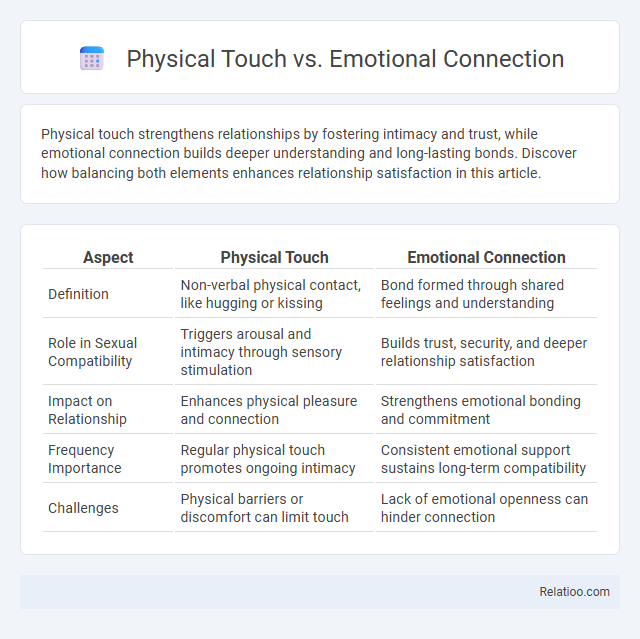Physical touch strengthens relationships by fostering intimacy and trust, while emotional connection builds deeper understanding and long-lasting bonds. Discover how balancing both elements enhances relationship satisfaction in this article.
Table of Comparison
| Aspect | Physical Touch | Emotional Connection |
|---|---|---|
| Definition | Non-verbal physical contact, like hugging or kissing | Bond formed through shared feelings and understanding |
| Role in Sexual Compatibility | Triggers arousal and intimacy through sensory stimulation | Builds trust, security, and deeper relationship satisfaction |
| Impact on Relationship | Enhances physical pleasure and connection | Strengthens emotional bonding and commitment |
| Frequency Importance | Regular physical touch promotes ongoing intimacy | Consistent emotional support sustains long-term compatibility |
| Challenges | Physical barriers or discomfort can limit touch | Lack of emotional openness can hinder connection |
Defining Physical Touch and Emotional Connection
Physical touch involves direct bodily contact, such as hugging or holding hands, which activates sensory receptors to convey comfort and bonding. Emotional connection refers to the deep sense of understanding, trust, and empathy shared between individuals, fostering intimacy beyond physical interactions. Both elements are distinct yet complementary components that influence relational dynamics and contribute to emotional well-being.
The Science Behind Physical Touch
Physical touch triggers the release of oxytocin, a hormone that enhances bonding and reduces stress by lowering cortisol levels. Neuroscientific studies reveal that tactile stimulation activates specific brain regions like the somatosensory cortex and insula, which process emotional and physical sensations simultaneously. This physiological response strengthens emotional connections and increases feelings of intimacy, distinguishing physical touch as a critical component in human relationships beyond mere arousal.
The Role of Emotional Connection in Relationships
Emotional connection acts as the foundation for deeper intimacy, enhancing the quality and satisfaction of physical touch and arousal in relationships. Neuroscientific studies reveal that strong emotional bonds release oxytocin, which amplifies feelings of trust and attachment, making physical touch more meaningful. Couples with high emotional connection report greater relationship stability and overall well-being, emphasizing its critical role beyond mere physical attraction or sexual arousal.
Physical Touch: Benefits and Drawbacks
Physical touch stimulates the release of oxytocin, promoting bonding, reducing stress, and enhancing emotional well-being. It can improve cardiovascular health by lowering blood pressure and heart rate but may also trigger discomfort or anxiety in individuals with touch sensitivity or trauma. Balancing physical touch with respect for personal boundaries ensures positive effects without causing distress.
Emotional Connection: Advantages and Challenges
Emotional connection fosters deep trust and intimacy, enhancing relationship satisfaction beyond physical touch or arousal alone. It promotes effective communication, empathy, and long-term bonding, which are essential for relationship resilience. Challenges include vulnerability, emotional dependency risks, and the need for ongoing effort to maintain mutual understanding and emotional safety.
How Physical Touch Influences Emotional Bonding
Physical touch releases oxytocin, a hormone that strengthens emotional bonds and fosters trust between partners. Your brain interprets tactile sensations as signals of safety and affection, which deepens emotional connection and intimacy. This biological response enhances emotional bonding beyond mere arousal, making physical touch a critical component in sustaining healthy relationships.
When Emotional Connection Surpasses Physical Touch
Emotional connection surpasses physical touch when deep feelings of trust, understanding, and mutual respect create a bond that goes beyond sensory experiences and fleeting physical sensations. This profound connection can ignite desire and arousal more powerfully than touch alone, as emotional intimacy fosters a safer environment for vulnerability and meaningful interactions. Studies reveal that couples reporting higher emotional closeness often experience enhanced sexual satisfaction and stronger relationship stability, highlighting the central role of emotional connection in sustaining arousal and fulfillment.
Balancing Physical Touch with Emotional Needs
Balancing physical touch with your emotional needs is essential for a healthy relationship, as physical intimacy alone cannot fulfill deep emotional connections or arousal. Prioritizing open communication about boundaries and feelings ensures that both physical affection and emotional closeness are nurtured in harmony. Achieving this balance enhances trust, intimacy, and overall relationship satisfaction.
Signs of Imbalance: Which Is Lacking?
Signs of imbalance between physical touch, emotional connection, and arousal often manifest as dissatisfaction or misunderstandings in relationships. A lack of physical touch may result in feelings of neglect or loneliness, whereas insufficient emotional connection can cause detachment and communication breakdowns. When arousal is missing, partners might experience frustration or a decrease in intimacy, highlighting the need to identify and address the specific area causing imbalance to restore harmony.
Building Stronger Bonds: Integrating Both Elements
Physical touch and emotional connection are essential components in building stronger bonds, as they engage different but complementary aspects of intimacy. Physical touch stimulates oxytocin release, fostering trust and closeness, while emotional connection reinforces understanding and empathy between partners. Integrating both elements enhances relationship satisfaction by creating a balanced dynamic that supports deeper attachment and mutual well-being.

Infographic: Physical Touch vs Emotional Connection
 relatioo.com
relatioo.com